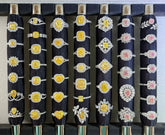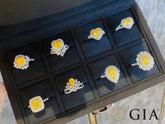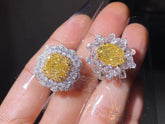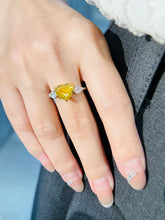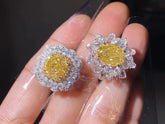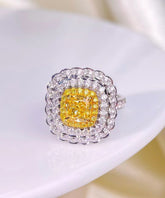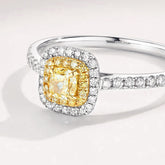The difference and price difference between GIA and IGI certificates.
In the world of diamonds, GIA (Gemological Institute of America) and IGI (International Gemological Institute) are undoubtedly the two giants. They are authoritative institutions in the field of diamond certification.

Since ancient times, diamonds have been hailed as the king of gemstones due to their rarity and inherent characteristics. As a luxury item, diamonds have garnered widespread acclaim. In recent years, with increasing fascination towards diamonds, their prices have surged. Diamonds not only offer unparalleled elegance but also symbolize the most beautiful aspects of love, becoming essential jewelry for weddings and engagements. Today, there are numerous diamond brands with varying prices. When purchasing diamonds, we often encounter diamond grading reports. These reports significantly influence diamond prices. Do you know the differences between the two popular international certificates, GIA and IGI?

One of the globally recognized authoritative diamond certificates is the GIA (Gemological Institute of America).
GIA certification

Introduction to GIA
GIA is a nonprofit organization funded by donations from the jewelry industry professionals. Its primary focus is on jewelry appraisal, professional education, and research, and it enjoys widespread recognition in the global jewelry industry. GIA pioneered the international promotion of diamond certification.
Founded in 1931 by Mr. Robert M. Shipley, GIA has expanded globally with fourteen educational institutions offering professional courses in research, sales, and appraisal. It has cultivated highly skilled professionals in the jewelry industry, earning a prestigious reputation worldwide. GIA's introduction of the 4C standard has become a universal benchmark in the international jewelry sector.
As the Gemological Institute of America, GIA has been at the forefront of standardizing the jewelry industry and making certifications accessible to the public. Its establishment coincided with the period of rapid industrial and consumer growth in the United States during the 1950s, necessitating a standardized, mass-replicable system to meet the increasing demand for diamonds. GIA foresightedly summarized previous industry practices and formalized concepts like 'clarity' and 'color,' leading to the official introduction of the 4C concept in the 1950s. This significantly facilitated the rapid development of the jewelry industry and subsequently introduced numerous gemological instruments for efficient gem appraisal.
GIA is known for its standardized approach, akin to assembly-line production. Regardless of whether the jewelry is from a celebrity or a street-side shop, both are certified using the same standardized formats and designs on GIA certificates. Certificates issued by GIA India, GIA USA, and GIA Hong Kong are indistinguishable in terms of their origin. Much like McDonald's or GAP in the United States, GIA provides certificates to every jeweler, teacher, fisherman, and worker worldwide, catering to the consumption needs of the majority of modern industrialized societies.
In China, following the reforms and opening up in the 1990s, GIA certificates flooded the market with a large influx of American diamonds, becoming one of the most recognized international certificates domestically.
One of the globally recognized authoritative diamond certificates — IGI
IGI certification

Introduction to IGI
IGI is the world's largest independent laboratory with over 800 global expert members across more than ten countries. It pioneered patented inventions and technologies such as laser inscription, darkroom photography, and the international eight hearts and eight arrows evaluation standard. It also introduced the 3EX cut grading system, which is an internationally accepted standard for evaluating diamond cut grades, serving jewelry professionals in over 100 countries.
Established in 1975 in Antwerp, Belgium, the world diamond center, IGI (International Gemological Institute) is the largest independent jewelry appraisal laboratory globally. It operates fifteen laboratories in major diamond trading centers including Antwerp, New York, Toronto, Dubai, Tokyo, Hong Kong, Tel Aviv, Los Angeles, and Mumbai, earning the reputation as 'the consumer's trusted appraisal authority.'

Initially, IGI provided private diamond appraisals for a few diamond families in Belgium. Later, as high-quality large diamonds were sold to various European royal families, IGI's reputation spread among royalty. Consequently, European, Middle Eastern, and Asian royal families began sending intricately crafted jewelry pieces that regular appraisers found challenging to analyze, prompting IGI to evolve from solely diamond appraisal to a specialized global gemological institution for diamonds and high-end jewelry. With its special clientele in mind, IGI not only provides gemological information but also adheres to luxury craftsmanship standards in every certificate, ensuring all quality aspects match the jewelry. Based on authoritative research in diamond cutting, IGI formulated the world's first comprehensive diamond cut grading chart, becoming the prototype for modern diamond cut grading systems. In 2007, IGI's chief appraiser was appointed as a diamond advisor to the Belgian Ministry of Foreign Affairs.
The advent of the modern commercial era expanded IGI's services. IGI certificates transitioned from being circulated only within the high-end jewelry circles to being introduced to a broader consumer base by jewelers. However, IGI certificates retained their European bespoke craftsmanship, manual production, and included features like laser inscription photos and exquisite jewelry photos. Today, IGI's customized certificates can be found in high-end jewelry collections of famous brands such as Dior and Montblanc, and celebrities like Paris Hilton have had their pink diamond watches certified by IGI. This legacy is tied to IGI's historical roots, resembling European couturiers who provide tailored certificates that highlight product characteristics for elite clients.
As one of the world's three major authoritative appraisal institutions with a truly global network of laboratories, IGI has maintained high standard uniformity across its labs, garnering widespread respect in the industry. Renowned international brands like Mont Blanc, Cartier, and Escada choose IGI for appraisal or training services.
Three, the differences between GIA and IGI diamond certificates While GIA and IGI are both prominent diamond appraisal institutions, they have distinct differences. GIA, founded in the United States with a significant historical development, primarily follows industry standards for its certification. This means that most diamond jewelry we see uses GIA certificates, whether from large jewelry stores or smaller shops, making GIA certificates more mainstream. On the other hand, IGI, although founded later, initially served a select clientele, usually appraising high-end diamonds. As IGI developed, it became a leader in high-end diamonds because its certificates continue to maintain traditional craftsmanship such as manual production and target high-end jewelry brands. From these perspectives, it is clear that these two certificates have differences, but both are world-class authoritative appraisal institutions that provide assurance when purchasing diamonds.

Four, price difference between GIA and IGI diamond certificates For the same diamond with identical weight and clarity, there can be a significant price difference between GIA and IGI certificates. Typically, diamonds certified by IGI tend to be more expensive due to the exclusivity of IGI certificates. The high-end nature of diamonds certified by IGI reflects its choice of high-end appraisal institutions. In contrast, diamond jewelry certified by GIA tends to be priced lower because GIA certificates cater to a more mainstream consumer base, influencing the price differences between diamond jewelry certified by these two institutions. In fact, regardless of which type of diamond appraisal certificate we choose, it can help us buy diamonds, and choose the best certificate, like buying a car, BMW and Mercedes-Benz, and playing a utility tool, as well as that we have said unto.
